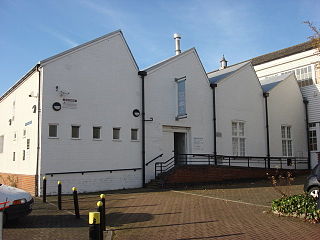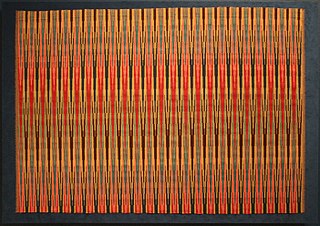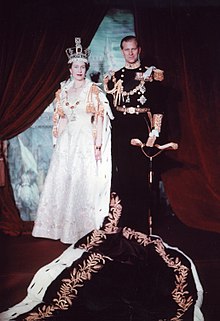
Weaving is a method of textile production in which two distinct sets of yarns or threads are interlaced at right angles to form a fabric or cloth. Other methods are knitting, crocheting, felting, and braiding or plaiting. The longitudinal threads are called the warp and the lateral threads are the weft, woof, or filling. The method in which these threads are interwoven affects the characteristics of the cloth. Cloth is usually woven on a loom, a device that holds the warp threads in place while filling threads are woven through them. A fabric band that meets this definition of cloth can also be made using other methods, including tablet weaving, back strap loom, or other techniques that can be done without looms.

Velvet is a type of woven tufted fabric in which the cut threads are evenly distributed, with a short pile, giving it a distinctive soft feel. By extension, the word velvety means "smooth like velvet". In the past, velvet was typically made from silk. Today, velvet can be made from linen, cotton, wool and synthetic fibers.

A bathrobe, also known as a housecoat or a dressing gown, is a loose-fitting outer garment worn by people, often after washing the body or around a pool. A bathrobe is considered to be very informal clothing, and is not worn with everyday clothes.

Silk In India, about 97% of the raw mulberry silk is produced in the Indian states of Karnataka, Andhra Pradesh, Tamil Nadu and West Bengal. Mysore and North Bangalore, the upcoming site of a US$20 million "Silk City", contribute to a majority of silk production. Another emerging silk producer is Tamil Nadu where mulberry cultivation is concentrated in Salem, Erode and Dharmapuri districts. Hyderabad, Andhra Pradesh and Gobichettipalayam, Tamil Nadu were the first locations to have automated silk reeling units.
The manufacture of textiles is one of the oldest of human technologies. To make textiles, the first requirement is a source of fiber from which a yarn can be made, primarily by spinning. The yarn is processed by knitting or weaving, which turns yarn into cloth. The machine used for weaving is the loom. For decoration, the process of colouring yarn or the finished material is dyeing. For more information of the various steps, see textile manufacturing.
Alec Hunter Academy is a secondary school with academy status located in East Braintree, Essex, England.

Marianne Straub OBE was one of the leading commercial designers of textiles in Britain in the period from the 1940s to 1960s. She said her overriding aim was: "to design things which people could afford. ... To remain a handweaver did not seem satisfactory in this age of mass-production".

Byzantine silk is silk woven in the Byzantine Empire (Byzantium) from about the fourth century until the Fall of Constantinople in 1453.

Queen Elizabeth II's coronation took place on 2 June 1953. Ordered in October 1952, her gown took eight months of research, design, workmanship, and intricate embroidery to complete. It featured the floral emblems of the countries of the United Kingdom and those of the other states within the Commonwealth of Nations, including the English Tudor rose, Scots thistle, Welsh leek, Irish shamrock, Canadian maple leaf, Australian wattle, New Zealand silver fern, South African protea, Indian lotus flower for India, the Lotus flower of Ceylon, and Pakistan's wheat, cotton, and jute.

The Warner Textile Archive is a UK-based collection of textiles, designs and paper records operated by Braintree District Museum Trust. It opened in 1993 and is the second largest collection of publicly-owned textiles in the UK.

Warp printing is a fabric production method which combines textile printing and weaving to create a distinctively patterned fabric, usually in silk. The warp threads of the fabric are printed before weaving to create a softly blurred, vague pastel-coloured pattern. It was particularly fashionable in the eighteenth century for summer wear.

Vrindavani Vastra is a drape woven by Assamese weavers led by Mathuradas Burha Aata during 16th century under the guidance of Srimanta Sankardeva, a Vaishnavite saint and scholar who lived in present-day Assam. The lead weaver Mathuradas Burha Aata a disciple of Sri Sri Madhabdev was the first Satradhikar of the great Barpeta satra. Mathuradas Burha Aata along with his 12 assistant weavers wove the Brindavani Bastra. The large drape illustrates the childhood activities of Lord Krishna in Vrindavan. Parts of the original Vrindavani vastra are presently owned by the Victoria and Albert Museum in London and Musee Guimet in Paris. The piece of cloth demonstrates the skillful weaving methods developed during medieval times and such complexity is rarely seen in present-day Assam.

Osborne & Little is a British manufacturer and retailer of upmarket wallpaper and fabrics. It was established in 1968 and now has showrooms worldwide. It was among the brands included in the Victoria and Albert Museum's British Design 1948–2012: Innovation in the Modern Age exhibition in 2012.
Isabel Tisdall was a British-based textile designer, who influenced domestic and commercial interior design through Tamesa Fabrics, which she founded in 1964, and via her work with Edinburgh Weavers from the mid 1950s. Prior to that, she had a successful career as a fashion stylist, including a period as fashion editor of Vogue.
Hans Tisdall, was a German-born artist, who worked in the UK as a designer and teacher. He is largely remembered for his bookjacket and textile designs.
Marion Victoria Dorn also known as Marion Dorn Kauffer was a textile designer primarily in the form of wall hangings, carpeting and rugs, however she is also known to have produced wallpaper, graphics, and illustrations. Known for her significant contributions to modern British interiors in particular for her 'sculpted' carpets, she contributed to some of the best-known interiors of the time including the Savoy Hotel, Claridges, the Orion and the Queen Mary. In the late 1930s and early 1940s she created moquette fabric designs for use in London Transport passenger vehicles.
Marianne Strengell was an influential Finnish-American Modernist textile designer in the twentieth century. Strengell was a professor at Cranbrook Academy of Art from 1937 to 1942, and she served as department head from 1942 to 1962. She was able to translate hand-woven patterns for mechanized production, and pioneered the use of synthetic fibers.

Handloom saris are a traditional textile art of Bangladesh and India. The production of handloom saris are important for economic development in rural India.

Lotus silk is a type of textile produced using delicate lotus stem fibers. The fabric first originated in Myanmar (Burma), and is now also woven by smaller-scale cottage industries in Vietnam. Due to the complexity and labor-intensive nature of weaving lotus fibers, lotus silk is considered one of the most expensive fabrics in the world. Burmese lotus silk uses fibres from a specific variety of lotus called padonma kya (ပဒုမ္မာကြာ), which produces large, fragrant pink flowers.

Brocatelle is a silk-rich fabric with heavy brocade designs. The material is characterized by satin effects standing out in relief in the warp against a flat ground. It is produced with jacquard weave by using silk, rayon, cotton, or many synthetic yarns.














